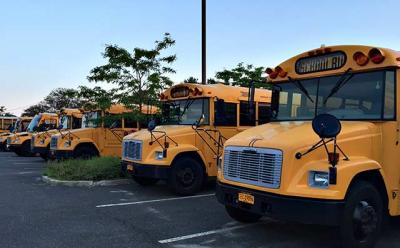East Hampton School District Aims to Build a Better Bus System

The East Hampton School District is embarking on a study of its transportation system following discussions at two school board meetings that yielded a general agreement that the district is on the right path in running its own bus system as opposed to hiring the services of a contractor.
But Richard Burns, the district’s superintendent, said during Tuesday’s school board meeting that he suspects there are ways to do things better, and is planning a public forum for sometime in October, most likely the board’s second meeting of the month on Oct. 20, to present data and gather public feedback.
One topic of debate seems to be the bus depot, which occupies a commercial property on Route 114 that is leased from a private company for more than $103,000 a year. School board members and administrators are wondering whether it makes sense to continue to lease a bus facility or find a way to purchase land for such a purpose. East Hampton has two more years on its bus depot lease.
“Every year it goes up,” said Isabel Madison, East Hampton’s assistant superintendent for business.
In 2010, voters in East Hampton overwhelmingly rejected a proposal that would have seen the district purchase the former Verizon building on King Street for more than $4.5 million to use as a bus depot. East Hampton has been operating its own transportation department since 2006, when its contractor, Schaefer and Sons, closed its business.
According to its 2015-16 budget, East Hampton will spend about $1.6 million on transportation this year. Ms. Madison said the largest percentage of that is spent on salaries and benefits for the district’s 28 full-time and four part-time bus drivers, many of whom also take on other duties during the school day such as running copy machine rooms and staffing the cafeterias.
East Hampton officials compared the district’s fleet of 35 buses, as well as its overall size and student population, to that of the Hampton Bays District. According to Ms. Madison, Hampton Bays spends about $2 million to contract out for its bus services but is considering taking its transportation system in-house.
“There are certain things you don’t have any control over when you’re contractual because you are always at the mercy of the companies,” she said. “I found the data from when we moved from contractual to being our own department. . . . Obviously, it is the decision of the board if you want to stay in the business of having our own transportation department, but I think [an outside contractor] would be more expensive than what it is now.”
The data Ms. Madison was referring to was not made available during the board meeting on Tuesday.
During a similar discussion on Aug. 4, Mr. Burns said, “ I think we need to come up with a long-range plan. . . . There are many questions that are coming up in terms of the bus depot. Is it large enough? Is it safe? The most basic question for us is should we be in the transportation business?”
But the board seemed to agree on Tuesday that the district is better off running its own buses. John Ryan Sr., who returned to the board this year after serving six previous terms on the school board, recalled that there were really no reasonable options for transportation toward the end of his previous tenure on the board.
“We were left with one vendor who was taking advantage of us already — this is my opinion and maybe I’m wrong — so we were forced to start this,” he said. “But I believe even as we started it, we saved the district money. The other very, very important thing is I believe that we give a better job to our bus drivers than the private companies do.”
Rich Wilson, another board member, and Christina DeSanti, the board vice president, both said the in-house screening of bus drivers is extremely important. J.P. Foster, the board president, raised the issue of transportation to activities and sports.
“If we need a bus to go somewhere, you can do that. If you call a company, not only may you not get it, but it would be a line item in the budget of an above- and-beyond cost,” Mr. Foster said.
Mr. Burns summed it up by saying that running the district’s own buses “is more efficient and safer,” but added, “I think we have to look at what is the most efficient way of running the bus department. I think we need input from the community.”
